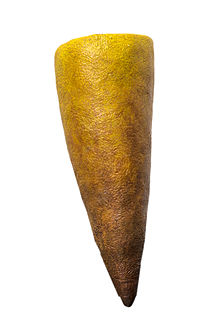Thectardis
| Thectardis | ||||
|---|---|---|---|---|

Reconstruction of Thectardis |
||||
| Temporal occurrence | ||||
| Ediacarium | ||||
| 575 to 565 million years | ||||
| Locations | ||||
| Systematics | ||||
|
||||
| Scientific name | ||||
| Thectardis | ||||
| Clapham et al., 2004 | ||||
| species | ||||
|
||||
Thectardis is an extinct animal genus of the Ediacarium of uncertain taxonomic classification.
etymology
The generic name Thectardis is a combination of the ancient Greek words thektos (tapered sharply) and ardis (arrowhead). The species name avalonensis is derived from the type locality , the Avalon Peninsula in Newfoundland .
Initial description
Thectardis avalonensis was first scientifically described in 2004 by Matthew E. Clapham and colleagues.
Occurrence
Thectardis has so far only been found at the type locality, Mistaken Point in Newfoundland. A total of 205 fossil finds are known that occur on two different strata, which are lithologically 2000 meters and chronologically 10 million years apart. The older strata is in the upper Drook Formation and is 575 million years old BP , while the younger strata belongs to the upper portion of the Mistaken Point Formation and is 565 ± 3 million years old BP.
Socialization
Thectardis can be associated with the following taxa:
description

Fossils from Thectardis , all of which have been preserved as slightly protruding, positive epi relief on the top of the layer, reveal a triangular figure on the layer surfaces . Raised, 5 to 7 millimeters wide edges and a central indentation indicate, however, that it is in reality a cone with its tip in the sediment. The cone length can vary from 2.6 to 16.5 centimeters, the width from 2.4 to 9.6 centimeters. The ratio of height to width remains roughly constant - fossils on the older layer surface have a ratio of 1 to 2.5, whereas the fossils on the younger layer surface can achieve a slightly higher ratio (1 to 3). This more or less constant ratio also suggests that the organism grew upwards from the tip stuck in the sediment. The inside of the cone is either smooth and undecorated or with indistinct, transverse markings. The latter characteristic seems to be limited to the members of the layer surface in the hanging wall.
ecology
Water currents could overturn the triangular fossils directed. If they fell on other objects, they would bend over their abutment. In the living position, the organisms stuck their point like needles in a pincushion into the agglutinating microbial mats of the Ediacarium, which coated and agglutinate the surface of the sediment, resembling upturned cones.
Thectardis very likely lived on suspended food particles. Since no adhesive discs have survived, it remains a mystery how the fossil was ultimately attached to the substrate.
Individual evidence
- ^ A b Clapham, Matthew E., Narbonne, Guy M., Gehling, James G., Greentree, Carolyn and Anderson, Michael M .: Thectardis avalonensis: A New Ediacaran Fossil from the Mistaken Point Biota, Newfoundland . In: Journal of Paleontology . tape 78 (6) , 2004, pp. 1031-1036 , doi : 10.1666 / 0022-3360 (2004) 0llllllllllll; 78 <1031: TAANEF> 2.0.CO; 2 .
- ↑ Bowring, SA et al .: Geochronological constraints on terminal Neoproterozoic events and the rise of metazoans . In: NASA Astrobiology Institute General Meeting Abstracts . 2003, p. 113-114 .
- ↑ Benus, AP: Sedimentological context of a deep-water Ediacaran fauna (Mistaken Point, Avalon Zone, eastern Newfoundland) . Ed .: Landing, E. et al., Trace Fossils, Small Shelly Fossils, and the Precambrian-Cambrian boundary. New York State Museum and Geological Survey Bulletin. tape 463 , 1988, pp. 8-9 .